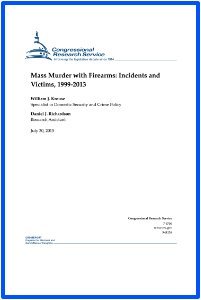By William Krouse and Daniel J. Richardson
In the wake of tragedy in Newtown CT, Congress defined “mass killings” as “3 or more killings in a single incident” (P.L. 112-265). Any consideration of new or existing gun laws that follows mass shootings is likely to generate requests for comprehensive data on the prevalence and deadliness of these incidents. Despite the pathos of mass shootings, only a handful of researchers and journalists have analyzed the principal source of homicide data in the United States—the Supplementary Homicide Reports (SHR) compiled by the Federal Bureau of Investigation (FBI)—to determine whether those incidents have become more prevalent and deadly. According to the FBI, the term “mass murder” has been defined generally as a multiple homicide incident in which four or more victims are murdered, within one event, and in one or more locations in close geographical proximity. Based on this definition, for the purposes of this report, “mass shooting” is defined as a multiple homicide incident in which four or more victims are murdered with firearms, within one event, and in one or more locations in close proximity. Similarly, a “mass public shooting” is defined to mean a multiple homicide incident in which four or more victims are murdered with firearms, within one event, in at least one or more public locations, such as, a workplace, school, restaurant, house of worship, neighborhood, or other public setting. This report analyzes mass shootings for a 15-year period (1999-2013). CRS analysis of the FBI SHR dataset and other research indicates that offenders committed at least 317 mass shootings, murdered 1,554 victims, and nonfatally wounded another 441 victims entirely with firearms during that 15-year period. The prevalence of mass shooting incidents and victim counts fluctuated sporadically from year to year. For the period 2007-2013, the annual averages for both incidents and victim counts were slightly higher than the years from 1999-2007.
Washington, DC: Congressional Research Service, 2015. 51p.






